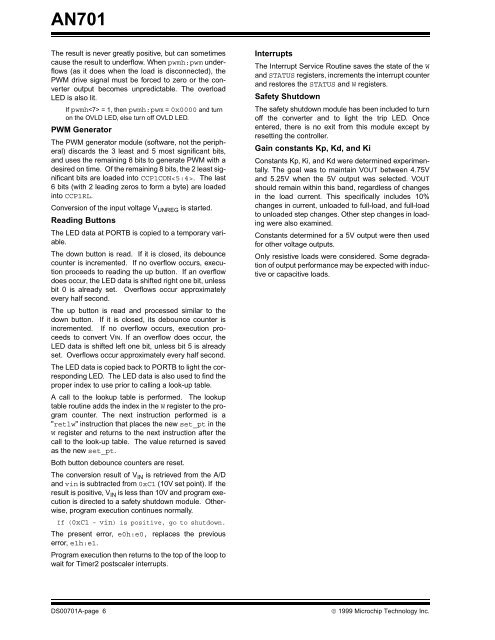Switch Mode Battery Eliminator Based on a PIC16C72A - Microchip
Switch Mode Battery Eliminator Based on a PIC16C72A - Microchip
Switch Mode Battery Eliminator Based on a PIC16C72A - Microchip
Create successful ePaper yourself
Turn your PDF publications into a flip-book with our unique Google optimized e-Paper software.
AN701<br />
The result is never greatly positive, but can sometimes<br />
cause the result to underflow. When pwmh:pwm underflows<br />
(as it does when the load is disc<strong>on</strong>nected), the<br />
PWM drive signal must be forced to zero or the c<strong>on</strong>verter<br />
output becomes unpredictable. The overload<br />
LED is also lit.<br />
If pwmh = 1, then pwmh:pwm = 0x0000 and turn<br />
<strong>on</strong> the OVLD LED, else turn off OVLD LED.<br />
PWM Generator<br />
The PWM generator module (software, not the peripheral)<br />
discards the 3 least and 5 most significant bits,<br />
and uses the remaining 8 bits to generate PWM with a<br />
desired <strong>on</strong> time. Of the remaining 8 bits, the 2 least significant<br />
bits are loaded into CCP1CON. The last<br />
6 bits (with 2 leading zeros to form a byte) are loaded<br />
into CCP1RL.<br />
C<strong>on</strong>versi<strong>on</strong> of the input voltage VUNREG is started.<br />
Reading Butt<strong>on</strong>s<br />
The LED data at PORTB is copied to a temporary variable.<br />
The down butt<strong>on</strong> is read. If it is closed, its debounce<br />
counter is incremented. If no overflow occurs, executi<strong>on</strong><br />
proceeds to reading the up butt<strong>on</strong>. If an overflow<br />
does occur, the LED data is shifted right <strong>on</strong>e bit, unless<br />
bit 0 is already set. Overflows occur approximately<br />
every half sec<strong>on</strong>d.<br />
The up butt<strong>on</strong> is read and processed similar to the<br />
down butt<strong>on</strong>. If it is closed, its debounce counter is<br />
incremented. If no overflow occurs, executi<strong>on</strong> proceeds<br />
to c<strong>on</strong>vert VIN. If an overflow does occur, the<br />
LED data is shifted left <strong>on</strong>e bit, unless bit 5 is already<br />
set. Overflows occur approximately every half sec<strong>on</strong>d.<br />
The LED data is copied back to PORTB to light the corresp<strong>on</strong>ding<br />
LED. The LED data is also used to find the<br />
proper index to use prior to calling a look-up table.<br />
A call to the lookup table is performed. The lookup<br />
table routine adds the index in the W register to the program<br />
counter. The next instructi<strong>on</strong> performed is a<br />
"retlw" instructi<strong>on</strong> that places the new set_pt in the<br />
W register and returns to the next instructi<strong>on</strong> after the<br />
call to the look-up table. The value returned is saved<br />
as the new set_pt.<br />
Both butt<strong>on</strong> debounce counters are reset.<br />
The c<strong>on</strong>versi<strong>on</strong> result of VIN is retrieved from the A/D<br />
and vin is subtracted from 0xC1 (10V set point). If the<br />
result is positive, VIN is less than 10V and program executi<strong>on</strong><br />
is directed to a safety shutdown module. Otherwise,<br />
program executi<strong>on</strong> c<strong>on</strong>tinues normally.<br />
If (0xC1 – vin) is positive, go to shutdown.<br />
The present error, e0h:e0, replaces the previous<br />
error, e1h:e1.<br />
Program executi<strong>on</strong> then returns to the top of the loop to<br />
wait for Timer2 postscaler interrupts.<br />
Interrupts<br />
The Interrupt Service Routine saves the state of the W<br />
and STATUS registers, increments the interrupt counter<br />
and restores the STATUS and W registers.<br />
Safety Shutdown<br />
The safety shutdown module has been included to turn<br />
off the c<strong>on</strong>verter and to light the trip LED. Once<br />
entered, there is no exit from this module except by<br />
resetting the c<strong>on</strong>troller.<br />
Gain c<strong>on</strong>stants Kp, Kd, and Ki<br />
C<strong>on</strong>stants Kp, Ki, and Kd were determined experimentally.<br />
The goal was to maintain VOUT between 4.75V<br />
and 5.25V when the 5V output was selected. VOUT<br />
should remain within this band, regardless of changes<br />
in the load current. This specifically includes 10%<br />
changes in current, unloaded to full-load, and full-load<br />
to unloaded step changes. Other step changes in loading<br />
were also examined.<br />
C<strong>on</strong>stants determined for a 5V output were then used<br />
for other voltage outputs.<br />
Only resistive loads were c<strong>on</strong>sidered. Some degradati<strong>on</strong><br />
of output performance may be expected with inductive<br />
or capacitive loads.<br />
DS00701A-page 6 © 1999 <strong>Microchip</strong> Technology Inc.

















